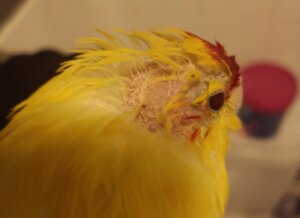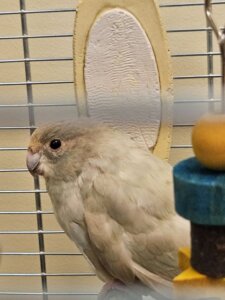How To Cut Kakariki Nails: Expert Tips for Safe Trimming
Cutting Kakariki nails can be tricky. It’s essential for their health and comfort.
Kakarikis are lively, colorful parrots with unique needs. Their nails grow continuously and can become too long if not trimmed. Overgrown nails may cause discomfort or even injury. Learning to cut your Kakariki’s nails is crucial for their well-being. This task might seem daunting at first, but with the right approach, you can do it safely and effectively.
This guide will help you understand the process step by step, ensuring your Kakariki stays happy and healthy. Ready to learn how to cut Kakariki nails? Let’s dive in!

Credit: www.youtube.com
Preparation
Preparing to cut your Kakariki’s nails is crucial for a smooth process. Proper preparation ensures that both you and your bird are comfortable. This section will guide you through the essential steps.
Gathering Supplies
First, gather all the necessary supplies. You will need a pair of bird nail clippers. You can find these at pet stores. Also, have a styptic powder ready. It helps to stop any bleeding. You may also need a towel to gently hold your Kakariki.
Choosing The Right Time
Next, choose the right time for the nail trimming. It’s best to do this when your bird is calm. Early morning or late evening are good times. Avoid times when your Kakariki is very active or stressed.
Understanding Kakariki Behavior
Kakarikis are active and curious birds. They love to explore their surroundings. Before cutting their nails, it’s important to understand their behavior. This understanding will help you handle your bird with care.
Handling Your Bird
Gently pick up your Kakariki. Support its body with one hand. Use the other hand to hold its feet. Speak softly to keep it calm. Avoid sudden movements. They can scare the bird. Practice this regularly. It helps your bird get used to being handled.
Recognizing Stress Signs
Kakarikis show signs when stressed. They may fluff their feathers. Their breathing may become fast. They might try to bite or escape. If you see these signs, stop and let the bird relax. Stress can harm your bird. Always ensure your bird feels safe.
Setting Up The Trimming Area
Prepare a clean, well-lit area with a comfortable surface to place your Kakariki. Ensure all trimming tools are within reach for ease and safety.
Setting up the right area is key for trimming your Kakariki’s nails. A calm and well-lit space helps both you and your bird feel at ease. Let’s explore how to create this perfect environment.Creating A Calm Environment
Choose a quiet room away from distractions. Turn off the TV and lower any loud noises. This will help your Kakariki stay calm. Place your bird on a stable surface like a table or counter. Have a towel or soft cloth handy to wrap your bird gently. This will keep them still and reduce stress.Ensuring Proper Lighting
Good lighting is crucial for nail trimming. Use natural light if possible. If not, a bright lamp will do. The light should be strong enough to see the nails clearly. Avoid shadows and dim areas. This will help you avoid cutting too much and hurting your bird. “`
Credit: leashingler.wixsite.com
Inspecting The Nails
Inspecting your Kakariki’s nails is an important part of their grooming routine. Regular checks ensure their nails are in good condition and not causing any discomfort. This section will guide you on how to properly inspect your Kakariki’s nails.
Identifying Overgrown Nails
First, look at the length of the nails. Overgrown nails are usually long and may curl. They can make it hard for your bird to perch. Your Kakariki might also get its nails caught on things. This can lead to injury. Short nails are less likely to cause problems. Regular trimming helps keep them at the right length.
Checking For Health Issues
Next, examine the nails closely. Check for any signs of health problems. Look for cracks, splits, or discoloration. Healthy nails are smooth and even. If you see any issues, it might be a sign of a health problem. In such cases, consult your vet for advice. They can help diagnose and treat any underlying issues.
Trimming Techniques
Trimming your Kakariki’s nails is vital for their health and comfort. Knowing the right techniques ensures a safe and stress-free experience for both you and your bird. Let’s dive into the proper methods for trimming their nails.
Using Nail Clippers
Start by choosing the right nail clippers. Small, bird-specific clippers work best. Hold your Kakariki gently but firmly. This prevents sudden movements.
Identify the nail’s tip. Clip only the sharp end. Make small cuts to avoid cutting too much at once. This approach reduces the risk of injury.
If your bird resists, take a break. Resume once they are calm. Consistency helps in making the process easier over time.
Avoiding The Quick
The quick is the pink area inside the nail. Cutting it causes bleeding and pain. Hold the nail against a light to see the quick clearly.
Trim in small increments. Stop once you approach the quick. Use a styptic powder if you accidentally cut the quick. This stops the bleeding quickly.
Regular trimming helps maintain healthy nail length. Check your Kakariki’s nails every few weeks.

Credit: www.youtube.com
Dealing With Accidents
Accidents can happen while cutting your Kakariki’s nails. It’s important to stay calm and know how to handle them. This section will guide you through dealing with common accidents, such as bleeding and providing first aid.
Handling Bleeding
If you accidentally cut your Kakariki’s nail too short, it may start bleeding. Don’t panic. This is common and can be managed easily. Here are the steps you should follow:
- Apply Pressure: Use a clean cloth or tissue to apply gentle pressure to the bleeding nail.
- Use Styptic Powder: Apply styptic powder to the nail to stop the bleeding. If you don’t have styptic powder, cornstarch or flour can be used as alternatives.
- Keep Calm: Remain calm to avoid stressing your bird. Speak softly and gently to reassure your Kakariki.
Providing First Aid
Providing first aid is crucial if your Kakariki’s nail is bleeding. Follow these steps to ensure proper care:
- Clean the Wound: Gently clean the area around the nail with warm water to remove any dirt or debris.
- Disinfect: Use a mild antiseptic solution to disinfect the wound. Be careful not to use anything too strong, as it can harm your bird.
- Monitor: Keep an eye on the nail for any signs of infection, such as redness or swelling. If you notice any issues, consult a veterinarian.
Remember, accidents happen, and knowing how to handle them is key. By following these steps, you can ensure your Kakariki remains healthy and safe during nail trimming.
Post-trimming Care
Post-trimming care is crucial to ensure your Kakariki remains healthy and happy. After trimming their nails, it’s important to provide a comfortable environment and closely monitor their behavior. This will help you identify any potential issues early on. Let’s dive into some essential steps for post-trimming care.
Offering Treats
After the trimming session, reward your Kakariki with their favorite treats. This will help them associate nail trimming with positive experiences. Use small pieces of fruit or their favorite seeds. Offering treats can also help soothe any stress they might feel.
Monitoring Behavior
Observe your Kakariki’s behavior closely for a few days after trimming. Look for signs of discomfort or changes in their activity levels. Check their feet regularly for any signs of redness or swelling. If you notice anything unusual, consult a vet promptly.
Regular Maintenance
Regular maintenance is essential for keeping your Kakariki’s nails in good shape. Overgrown nails can cause discomfort and health issues. By establishing a routine and providing natural ways for wear, you can ensure your bird’s nails stay at a healthy length.
Establishing A Routine
Establishing a routine is crucial for nail care. Regular checks will help you spot when your Kakariki’s nails are getting too long. Make it a habit to inspect their nails every week. Use a small flashlight to get a clear view. If you notice the nails are too long, it’s time for a trim. This will prevent overgrowth and reduce stress for your bird.
Using Perches For Natural Wear
Using perches for natural wear is an effective method to keep your Kakariki’s nails in check. Choose perches made from natural wood or concrete. These materials help wear down the nails naturally. Place the perches at different heights and angles. This will encourage your bird to climb and move around, promoting natural nail wear.
Rotate the perches regularly. This ensures even wear on all nails. Natural wear reduces the need for frequent trims, making nail care less stressful for your Kakariki.
Frequently Asked Questions
How Often To Cut Kakariki Nails?
You should cut Kakariki nails every 4-6 weeks. Regular trimming prevents overgrowth and discomfort.
What Tools Needed For Trimming Kakariki Nails?
Use small bird nail clippers or human baby nail clippers. Ensure they’re clean and sharp.
How To Calm Kakariki During Nail Trim?
Gently wrap your Kakariki in a soft towel. Speak softly and handle with care.
Can I Cut Kakariki Nails At Home?
Yes, you can cut their nails at home with proper tools and technique. Be gentle.
Conclusion
Trimming Kakariki nails is vital for their health. Use sharp, proper tools. Gently hold your bird to avoid stress. Trim only the tips to prevent injury. Check nails regularly and trim as needed. This routine keeps your Kakariki comfortable and happy.
If unsure, ask a vet for help. Happy trimming!
Hello Dear, I'm Poli Kolymnia, owner of many birds (including budgies).
With a deep passion for these feathered companions, I'm here to share my expertise and extensive knowledge on birds care.
My articles cover essential topics like diet, housing, care, and health, providing practical tips to help you create a happy and thriving environment for your birds.





